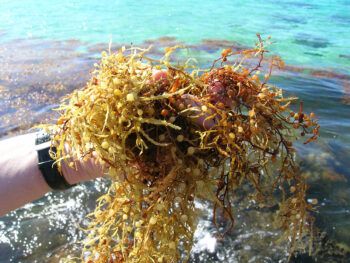Why Is There A ‘Seaweed Blob?’

Dubbed the “seaweed blob,” a nearly 5,000-mile-wide patch of seaweed — specifically, the brown algae Sargassum — is heading toward Florida and Caribbean beaches. Texas A&M Today spoke with Dr. Anna Armitage, professor of marine biology at Texas A&M University at Galveston, to learn more.
What are seaweeds and what are their purpose in the ocean?
Seaweeds are photosynthetic algae that live in the ocean. Although seaweed is photosynthetic, it differs from “typical” plants in several ways, including a unique reproductive cycle and the lack of a vascular system (xylem and phloem). Seaweed do not have true roots, but most use root-like structures to attach to hard surfaces on the ocean floor. A few types of seaweed, including Sargassum, are free-floating on the ocean surface. There it provides an important habitat for many marine organisms, including juvenile fish and invertebrates.
Is the 5,000-wide patch of sargassum unusual? What would cause it to be so large?
Sargassum abundance typically increases in the summer each year when there is an abundance of nutrients and sunlight. There is a lot of variability in when and where those patches are most dense. The patch off the U.S. coast this year is large for that region, but similarly large patches have occurred throughout the Caribbean many times over the last decade. The exact cause of seaweed blooms in a particular spot are not fully known, but are largely attributed to high nutrient availability due to pollution and warmer temperatures attributed to climate change.
What kinds of issues would you expect to see with a patch of this size?
The primary issues with a patch this large are aesthetic — rafts of Sargassum on public beaches are a nuisance for beachgoers. Ecologically, though, these mats of algae can have an important role to play in shoreline stabilization. As the algae decomposes on land, it will trap windblown sand and help reinforce and grow coastal dunes. This can have a long-term benefit for the coast.
What will happen to the seaweed collecting on beaches?
The actions taken will depend on decisions by local managers. In some cases, the algae will be removed and carted off to a landfill. In other cases, some or all of it may be moved up the beach to the dune line, where it can help fortify and grow coastal dunes. If no action is taken, it will eventually decompose and wash away.
Is there anything you’d like to add?
Sargassum has many important ecological roles both offshore and on the coast. Although large accumulations may be a temporary nuisance for beachgoers, there are benefits to the coast as well. One way we can lessen the severity of Sargassum bloom formation is to reduce nutrient input to coastal waters. Nutrient runoff is a type of pollution in coastal waters. Most nutrient runoff comes from excess fertilizer that is added to yards or agricultural fields. If the plants don’t use all the nutrients (like nitrogen or phosphorus) in the fertilizer, the excess nutrients end up washing into streams and rivers, and then eventually ends up in the ocean. Those excess nutrients can then fuel blooms of Sargassum and other algae. Another source of nutrients into the coastal environment is from wastewater disposal from sewage treatment plants.
So, addressing the Sargassum problem can start on land by reducing or being more efficient with fertilizer use, and by better management and treatment of wastewater.
Media contact: Lesley Henton, lshenton@tamu.edu





